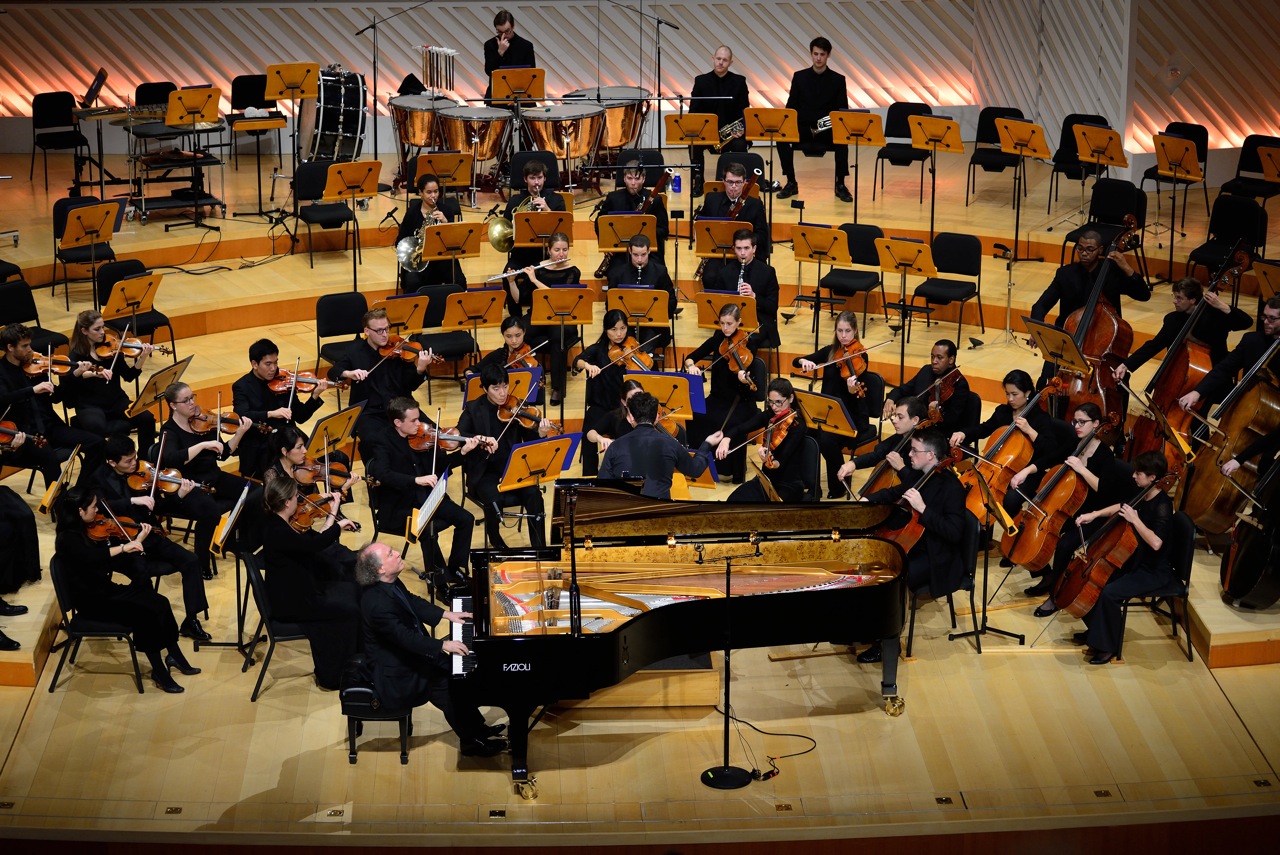
Conducted by James Gaffigan, the New World Symphony delivers a memorable performance
Above: The New World Symphony.
There are a number of reasons to suggest that the New World Symphony’s Jan. 30 concert in Miami, with James Gaffigan conducting and Jeffrey Kahane on the piano, was perhaps the best of the season. Though it wasn’t perfect, the hits far outnumbered the misses. Of the latter, there were so few that they are not worth mentioning. But what does need to be mentioned is, first, that pure music was made–music in capital letters, almost palpable in an electric atmosphere. Secondly, the program offered an excellent mix: a piece by the great César Franck, nowadays an almost forgotten composer; one of Mozart’s sublime piano concertos, a perfect tribute to his 260th birthday; and a magnificent Richard Strauss tone poem that is also one of the Bavarian composer’s most popular, thanks to its use in Stanley Kubrick’s “2001: A Space Odyssey.”
When the New World Symphony is in top shape, it proves that the vigor of youth is a composer’s best ally, capable of instilling new life into centuries-old work. It also showed Gaffigan’s skill, as he was clearly the driving force behind an outstanding concert.
The evening commenced with a brief, seldom-performed tone poem that served as an apt appetizer for the spectacular one that would follow in the second half of the concert. In barely 15 minutes, Franck’s “The Accursed Huntsman” (based on a ballad by German poet Gottfried August Bürger) sketched the phantasmagoric world of Hector Berlioz’s “Symphonie Fantastique,” with nods to Franz Liszt and Camille Saint-Säens. The work also foreshadows the interlude of Giacomo Puccini’s first opera, “Le Villi,” which he premiered the following year. The risky, brass-dominated beginning was executed with exemplary clarity and splendid support from the strings. Gaffigan’s vehemence added a welcome romantic touch to the powerful crescendo that describes the hunter’s mad ride and encounter with supernatural forces. It is a work that makes great demands on an orchestra, and the New World Symphony passed the test with flying colors, displaying the virtues of every instrument section, along with an impressive degree of self-assurance in expressing a dark romanticism that sounded more German than French.
In vivid contrast, harmony and serenity prevailed in Jeffrey Kahane’s performance of Mozart’s Piano Concerto No. 22 in E flat major. Kahane is an exceptional soloist, and he played on a new Fazioli piano that emitted a powerful yet extremely sweet sound. Kahane made the most of its pearly smoothness, delivering an intimate performance of irreproachable style and musicality, framed by the vibrant accompaniment of Gaffigan’s orchestra. Resolute, powerful, severe and classical, the performance had memorable interludes by Masha Popova’s flute, as well as the bassoons and clarinets. The ensemble exhibited the kind of “tender majesty” the piece calls for. Kahane performed his own cadenzas (Mozart had none) as purely as he played the entire concerto, peppered with allusions to Barbarina (“The Marriage of Figaro”) and Jeunehomme (Piano Concerto No. 9), all culminating in a delightful minuet and jubilant rondeau. Sadly, there was no encore.
The program shows film has done much to disseminate the classical repertoire–Kahane’s superb nod to “Amadeus” gave way to the strains of Kubrick’s “Space Odyssey.” The New World Symphony painted an absolutely dazzling “Sunrise,” preceded by the ominous C major chord that signals the beginning of the world, with a flourish that recalled Richard Wagner and the beginning of “Das Rheingold.” Like the earlier “Accursed Huntsman,” but to an even greater extent, the gigantic tone poem “Thus Spoke Zarathustra” provided each musician with a wonderful exercise and a unique opportunity to display his or her skill. It was a competition and challenge that the orchestra and Gaffigan obviously relished. Every instrument had the chance to show off, even the beautiful violas, the orchestra’s Cinderellas. Along with Julia Yang’s cello, they played a vital role in accentuating key moments.
In fact, all the strings delivered exceptional performances, with a welcome electricity that was muscular, more earthy than spiritual, more incisive than celestial. The playful Viennese waltz was of a rustic yet decadent nature, worthy of the best performances of “Der Rosenkavalier,” here done more in the vein of the work’s Mariandel character than Octavian. Also worthy of mention were the double basses in the section “Of Science and Learning,” the clarinet in “The Song of the Grave” and the trombone in “The Convalescent,” as well as the timpani and other percussion instruments at the end, in addition to the twelve chimes and the splendid work of the brass, beginning with the very risky role assigned to the trumpets.
Gaffigan excelled in his handling of sound layers, delivering a rich, vigorous, warm and persuasive performance, full of emphatic drama. If a certain sensuality was lacking, it was barely noticeable. The concert wasn’t visionary so much as it was a portrait of today’s world, with its deafening peaks and valleys. At the well-applauded end, the maestro had the grace to congratulate every member of the orchestra, and all responded with unusual affection.
Recent Content
-
Artsarticle ·
-
Artsarticle ·
-
Artsarticle ·
